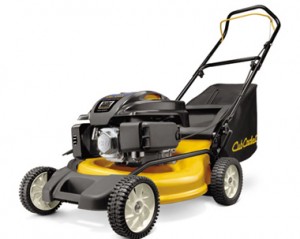What’s the difference between gas, diesel and non-detergent oil? How do you check the oil on a small engine? Why does it need to be checked before starting the engine? Here’s what you need to know to keep your Cub Cadet lubricated.
What Does Oil Do?
Oil does more than lubricate. It also suspends dirt, which keeps it from acting as an abrasive on internal components. If the oil is black, it’s dirty, but that means it’s doing its job.
Oil also transfers heat away from components. Most heat is generated around the combustion chamber where the fuel is burned. The oil absorbs this heat and transfers it to the rest of the engine where it can be removed by the cooling system.
How Does Oil Move Around?
Splash lubrication keeps the oil in the crankcase, letting the crankshaft spin through it. This throws the oil around the inside of the crankcase, lubricating the engine’s internal components. Some engines have a small rod called a “dipper” that extends into the oil to help sling it around the crankcase.
Some older engines combined splash lubrication with an oil pump that brought oil to the valvetrain. Newer commercial engines use a full pressure lubrication system that pumps oil to components from the crankshaft to the valve guides.
Types of Oils
The American Petroleum Institute (API) issues standards for lubricants based on their function. These standards are updated occasionally to meet new wear requirements, and each new standard is backward compatible.
The oil weight is based on how it flows at 212°F (100°C.) Most oils used also have a “W” rating for winter use. This is how fast the oil flows at 32°F (0°C.) These oils coat the engine faster when warming up and make the engine easier to start.
Motor oil is designed to withstand heat and acidic compounds inside the engine. Manufacturers of gasoline engines used in Cub Cadets recommend oil with an API Service Category of SJ or later. Any new bottle of oil you buy off the shelf today will meet this requirement. ILSAC GF-5 is equivalent to API SN, making it safe to use.10W-30 is recommended for gasoline engines of all makes under most operating conditions. Cub Cadet recommends 5W-30 for use in their own engines when operating at temperatures consistently below freezing.
Unlike gas engines, API service categories for obsolete diesels are still available, but nearly all off-the-shelf oils will fall under CJ-4, CK-4 or FA-4 categories which are compatible with any diesel used in Cub Cadet’s tractors. Recent Yanmar and Kubota diesel engines use 15W-40, while some older engines need SAE 30 diesel engine oil.
There are also a few other non-engine lubricants you may need for your equipment:
Gear oil is formulated to adhere to gears, even when at high pressures. Oil with an API service category of GL-4 or GL-5 is recommended. Recent equipment including tiller transmissions use 85W-140 gear oil.
SAE 30 non-detergent oil is used as a gear oil in low-pressure applications and is recommended as a lubricant for pivot points including the handle and cable anchors on Cub Cadet equipment. While detergents are good for keeping engines clean, they can leave a sticky residue on parts that operate in low-stress conditions. This oil will either have no API certification or be SA certified, which means it’s additive free. Diesel SAE 30 should not be used in place of non-detergent, and vice versa.
Hydraulic fluid is a standard oil formulation designed to transfer force through a hydraulic system. This is a standard formula, but some manufacturers also make their own oils designed to get the best performance and wear from their pumps and hydrostatic motors.
How Do I Check the Oil?
On all engines over 50cc, there is a dipstick/filler cap located on the engine opposite of the exhaust. This cap will either be yellow or have an oil can symbol on the top. Make sure the engine is level, then remove the dipstick and wipe off the oil. On Briggs & Stratton engines and Cub Cadet engines with a screw-in filler neck, insert the dipstick without pushing it in. On all other engines, screw or push the dipstick in all the way. Remove the dipstick and check where the oil clings between the marks. It should be above the low mark, and if you just changed the oil, it should be at the full mark. Some oil loss is normal on all small engines, so it’s best to check the oil before each use.
Where Can I Get OEM Lubricants and Filters?
If you’re looking for genuine Cub Cadet oil, filters or anything else for your equipment, visit www.cubparts.com. We’re a certified dealer for Cub Cadet and the manufacturers of the engines that power them so we can provide you with everything you need. We ship across the U.S. and Canada.

